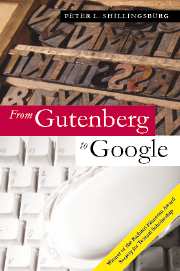Book contents
- Frontmatter
- Contents
- Introduction
- 1 Manuscript, book, and text in the twenty-first century
- 2 Complexity, endurance, accessibility, beauty, sophistication, and scholarship
- 3 Script act theory
- 4 An electronic infrastructure for representing script acts
- 5 Victorian fiction: shapes shaping reading
- 6 The dank cellar of electronic texts
- 7 Negotiating conflicting aims in textual scholarship
- 8 Hagiolatry, cultural engineering, monument building, and other functions of scholarly editing
- 9 The aesthetic object: “the subject of our mirth”
- 10 Ignorance in literary studies
- Bibliography
- Index
5 - Victorian fiction: shapes shaping reading
Published online by Cambridge University Press: 23 December 2009
- Frontmatter
- Contents
- Introduction
- 1 Manuscript, book, and text in the twenty-first century
- 2 Complexity, endurance, accessibility, beauty, sophistication, and scholarship
- 3 Script act theory
- 4 An electronic infrastructure for representing script acts
- 5 Victorian fiction: shapes shaping reading
- 6 The dank cellar of electronic texts
- 7 Negotiating conflicting aims in textual scholarship
- 8 Hagiolatry, cultural engineering, monument building, and other functions of scholarly editing
- 9 The aesthetic object: “the subject of our mirth”
- 10 Ignorance in literary studies
- Bibliography
- Index
Summary
Such dim-conceivéd glories of the brain
Bring round the heart an indescribable feud;
So do these wonders a most dizzy pain,
That mingles Grecian grandeur with the rude
Wasting of old Time – with a billowy main,
A sun, a shadow of a magnitude.
Keats, “On Seeing the Elgin Marbles for the First Time” (1817)Given the general, perhaps abstract, surveys of chapters three and four, about the complexity of script acts and problems of developing an electronic infrastructure to contain its knowledge sites, it is now time to turn to a different aspect of the complexities of moving print literature into electronic forms – to confront in one area the sheer enormity of and seemingly insurmountable obstacles facing such an enterprise. And yet, if the project is not conceived comprehensively and grandly, the results will fail to satisfy more from the failure to attempt a miracle than from its impossibility.
Much of literary theory and criticism of the past two or three decades has, perhaps ironically, been devoted to making us aware of our “situatedness” – of the ways in which our present time, our geographic and cultural place, our interests, our acknowledged and unacknowledged ideologies, and our personal experiences and skills or lack thereof limit, direct, and focus our critical insights and our sense of history.
- Type
- Chapter
- Information
- From Gutenberg to GoogleElectronic Representations of Literary Texts, pp. 126 - 137Publisher: Cambridge University PressPrint publication year: 2006
- 1
- Cited by



